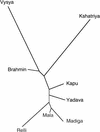Genetic evidence on the origins of Indian caste populations
- PMID: 11381027
- PMCID: PMC311057
- DOI: 10.1101/gr.gr-1733rr
Genetic evidence on the origins of Indian caste populations
Abstract
The origins and affinities of the approximately 1 billion people living on the subcontinent of India have long been contested. This is owing, in part, to the many different waves of immigrants that have influenced the genetic structure of India. In the most recent of these waves, Indo-European-speaking people from West Eurasia entered India from the Northwest and diffused throughout the subcontinent. They purportedly admixed with or displaced indigenous Dravidic-speaking populations. Subsequently they may have established the Hindu caste system and placed themselves primarily in castes of higher rank. To explore the impact of West Eurasians on contemporary Indian caste populations, we compared mtDNA (400 bp of hypervariable region 1 and 14 restriction site polymorphisms) and Y-chromosome (20 biallelic polymorphisms and 5 short tandem repeats) variation in approximately 265 males from eight castes of different rank to approximately 750 Africans, Asians, Europeans, and other Indians. For maternally inherited mtDNA, each caste is most similar to Asians. However, 20%-30% of Indian mtDNA haplotypes belong to West Eurasian haplogroups, and the frequency of these haplotypes is proportional to caste rank, the highest frequency of West Eurasian haplotypes being found in the upper castes. In contrast, for paternally inherited Y-chromosome variation each caste is more similar to Europeans than to Asians. Moreover, the affinity to Europeans is proportionate to caste rank, the upper castes being most similar to Europeans, particularly East Europeans. These findings are consistent with greater West Eurasian male admixture with castes of higher rank. Nevertheless, the mitochondrial genome and the Y chromosome each represents only a single haploid locus and is more susceptible to large stochastic variation, bottlenecks, and selective sweeps. Thus, to increase the power of our analysis, we assayed 40 independent, biparentally inherited autosomal loci (1 LINE-1 and 39 Alu elements) in all of the caste and continental populations (approximately 600 individuals). Analysis of these data demonstrated that the upper castes have a higher affinity to Europeans than to Asians, and the upper castes are significantly more similar to Europeans than are the lower castes. Collectively, all five datasets show a trend toward upper castes being more similar to Europeans, whereas lower castes are more similar to Asians. We conclude that Indian castes are most likely to be of proto-Asian origin with West Eurasian admixture resulting in rank-related and sex-specific differences in the genetic affinities of castes to Asians and Europeans.
Figures



Similar articles
-
Genetic affinities among the lower castes and tribal groups of India: inference from Y chromosome and mitochondrial DNA.BMC Genet. 2006 Aug 7;7:42. doi: 10.1186/1471-2156-7-42. BMC Genet. 2006. PMID: 16893451 Free PMC article.
-
Genetic variation in South Indian castes: evidence from Y-chromosome, mitochondrial, and autosomal polymorphisms.BMC Genet. 2008 Dec 12;9:86. doi: 10.1186/1471-2156-9-86. BMC Genet. 2008. PMID: 19077280 Free PMC article.
-
mtDNA variation in caste populations of Andhra Pradesh, India.Hum Biol. 1996 Feb;68(1):1-28. Hum Biol. 1996. PMID: 8907753
-
Complex genetic origin of Indian populations and its implications.J Biosci. 2012 Nov;37(5):911-9. doi: 10.1007/s12038-012-9256-9. J Biosci. 2012. PMID: 23107926 Review.
-
A comprehensive review of HVS-I mitochondrial DNA variation of 19 Iranian populations.Ann Hum Genet. 2024 May;88(3):259-277. doi: 10.1111/ahg.12544. Epub 2023 Dec 31. Ann Hum Genet. 2024. PMID: 38161274 Review.
Cited by
-
Population differentiation of southern Indian male lineages correlates with agricultural expansions predating the caste system.PLoS One. 2012;7(11):e50269. doi: 10.1371/journal.pone.0050269. Epub 2012 Nov 28. PLoS One. 2012. PMID: 23209694 Free PMC article.
-
Impact of restricted marital practices on genetic variation in an endogamous Gujarati group.Am J Phys Anthropol. 2012 Sep;149(1):92-103. doi: 10.1002/ajpa.22101. Epub 2012 Jun 23. Am J Phys Anthropol. 2012. PMID: 22729696 Free PMC article.
-
Phylogeny of mitochondrial DNA macrohaplogroup N in India, based on complete sequencing: implications for the peopling of South Asia.Am J Hum Genet. 2004 Dec;75(6):966-78. doi: 10.1086/425871. Epub 2004 Oct 1. Am J Hum Genet. 2004. PMID: 15467980 Free PMC article.
-
South Asia, the Andamanese, and the genetic evidence for an "early" human dispersal out of Africa.Am J Hum Genet. 2003 Jun;72(6):1586-90; author reply 1590-3. doi: 10.1086/375407. Am J Hum Genet. 2003. PMID: 12817589 Free PMC article. No abstract available.
-
Identification of polymorphic motifs using probabilistic search algorithms.Genome Res. 2005 Jan;15(1):67-77. doi: 10.1101/gr.2358005. Genome Res. 2005. PMID: 15632091 Free PMC article.
References
-
- Anderson S, Bankier AT, Barrell BG, de Bruijn MH, Coulson AR, Drouin J, Eperon IC, Nierlich DP, Roe BA, Sanger F, et al. Sequence and organization of the human mitochondrial genome. Nature. 1981;290:457–465. - PubMed
-
- Balakrishnan V. A preliminary study of genetic distances among some populations of the Indian sub-continent. J Hum Evol. 1978;7:67–75.
-
- ————— . Admixture as an evolutionary force in populations of the Indian sub-continent. In: Malhotra KC, Basu A, editors. Proceedings of the Indian Statistical Institute Golden Jubilee International Conference on Human Genetics and Adaptation. I. Calcutta: Indian Statistical Institute; 1982. pp. 103–145.
-
- Bamshad M, Fraley AE, Crawford MH, Cann RL, Busi BR, Naidu JM, Jorde LB. mtDNA variation in caste populations of Andhra Pradesh, India. Hum Biol. 1996;68:1–28. - PubMed
Publication types
MeSH terms
Substances
Grants and funding
LinkOut - more resources
Full Text Sources
Research Materials
